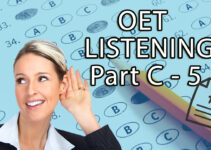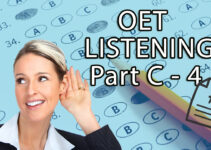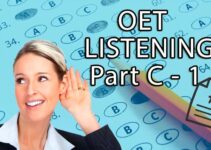Question
In this part of the test, you’ll hear two different extracts. In each extract, you’ll hear health professionals talking about specific aspects of their work.
For questions 31 to 42, choose the answer A, B or C which fits best according to what you hear. Complete your answers as you listen the audio.
Now look at extract one.
Extract 1: Question 31 to 36
You hear an interview with a sports injury specialist called Toby Walsh on the subject of hamstring injuries.
You have 90 seconds to read question 31 to 36
31. Toby explaines that sports people fear getting hamstring injuries because
A. it take a long time to recover from one.
B. there is a high risk of recurrence.
C. the therapy can be very painful.
32. Toby explains that hamstring injuries are common in sports which
A. ten to involve in very long matches.
B. are popular with players of different ages.
C. require players to move in certain ways.
33. In term of preventing hamstring injuries, Toby mentions that sports people need to
A. maintain ease of movement in another part of the body.
B. ensure that warm up exercises aren’t increasing the risk.
C. Be cautious about working directly on the muscles concerned
34. Toby suggest that during intensive training programs
A. pain in the hamstring should be seen as a warning sign.
B. working on the gluteal muscles can help to advoid hamstring problems.
C. people with history of hamstring strains need to advoid certain exercises.
35. What is Toby first concern treating a hamstring injury?
A. To get the arthlete to describe the symptoms.
B. To take actions to reduce any swelling.
C. To ensure that pain is well managed.
35. What is Toby first concern treating a hamstring injury?
A. To get the arthlete to describe the symptoms.
B. To take actions to reduce any swelling.
C. To ensure that pain is well managed.
36. What does Toby says about recovering from hamstring injuries?
A. The effects may be permanent in some cases.
B. Its hard to predict how long it will takein each case.
C. Treatment can be counter-productive in less severe cases.
Extract 2: Question 37 to 42
You hear a clinical pharmacist called Emme Royxe giving a presentation about the side effects of certain types of medication. You now have 90 seconds to read question 37 to 42
37. Emma explains that the condition known as pathological gambling
A. was first identified in patients with Parkinson’s disease.
B. affects a disproportionate number of Parkinson’s patients.
C. often occurs in parkinson’s patients whatever treatment they’re having
38. Emma says that pathological gambling as a side effect of Parkinson’s medications
A. may be more extensive that existing data suggests.
B. is probably restricted to patients with an existing disorder.
C. seem to have been over-estimated in the absence of reliable date
39. In the case patient called Harry what associated symptom led his wife to discover his gambling problem?
A. Insomnia
B. Loss of appetie
C. Compulsive shopping
40. What point does Emma make about the role of underlying risk factors in the development of pathological gambling?
A. Certain personal characteristics clearly play a part in this.
B. Prolonged exposure to the drugs makes this hard to assess.
C. There is a llack of conclusive evidence to back up claims about this.
41. Emma feels that the long term effects of the type of adverse reaction
A. can be extremely serious for the patients well being.
B. are limited because the symptoms soon disappear.
C. depend on the level of the support the patient has.
42. What does Emma suggest for the management of drug-included pathological gambling in Parkinson’s patients?
A. Patients should decide whether to continue with their medications.
B. Patients should be observed to see how severe their reaction is.
C. Patients should be taken off the medication as soon as possible.



Greetings!
(2024) OET Listening Part C – Test 3 audio is not available. without audio how i can resolve this .Please provide its audio.
Thanks in advance
Please check again. Audio is available
?